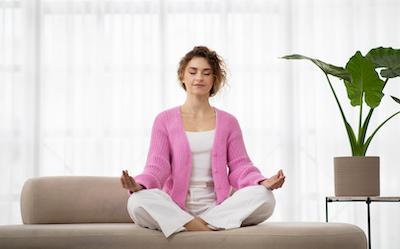In today’s fast-paced world, where stress and anxiety are all too common, our homes should serve as a sanctuary—a place where we can unwind, recharge, and find solace. Designing spaces within our homes that promote stress relief and relaxation is essential for nurturing our mental well-being. Be it a house with traditional walls or an apartment with limited square footage, or a beautiful big home with lots of windows and natural light, creating a home sanctuary is possible.

The windows and doors dublin can help you to create a sanctuary that suits your needs and reflects who you are.
In this article, we will explore the concept of a home sanctuary and provide practical tips on how to create tranquil spaces that foster calmness and serenity.
- Understand the Concept of a Home Sanctuary: A home sanctuary is a designated space within your home that is specifically designed to promote relaxation and rejuvenation. It is a personal retreat where you can escape from the demands of daily life and find inner peace. Whether it’s a cozy corner, a dedicated room, or an outdoor oasis, the key is to create an environment that appeals to your senses and calms your mind.
- Choose Soothing Colors and Lighting: Colors have a profound impact on our moods and emotions. When designing your home sanctuary, opt for soft, neutral tones such as pastels, earthy hues, or cool blues and greens. These colors create a serene and tranquil atmosphere. Avoid loud and vibrant colors that may be visually stimulating and induce anxiety. The painters dublin can help you to choose the right colors and other decorative elements for your sanctuary. Additionally, consider the lighting in your sanctuary. Natural light is ideal, as it provides a sense of openness and connection to the outdoors. If natural light is limited, incorporate soft and warm artificial lighting, such as dimmable lamps or candles, to create a cozy and relaxing ambiance.
- Incorporate Natural Elements: Bringing nature into your home sanctuary can have a profound impact on your well-being. Consider incorporating natural elements, such as indoor plants, a small water feature, or a Zen garden. These elements not only add visual appeal but also contribute to a sense of tranquility and connection with the natural world. Indoor plants, in particular, have been shown to improve air quality and reduce stress levels. Choose low-maintenance plants that thrive indoors, such as peace lilies, snake plants, or spider plants. Place them strategically throughout your sanctuary to create a calming and refreshing environment. You can even plant a lot of trees in your outdoor area to give your home that ultimate sanctuary feel. The tree surgeon dublin can help keep your trees healthy.
- Comfortable Seating and Cozy Textures: The seating in your home sanctuary should be inviting and comfortable. Invest in a cozy armchair, chaise lounge, or floor cushions where you can relax and unwind. Consider incorporating plush throws, soft pillows, and warm blankets to add layers of comfort and create a cozy atmosphere. In terms of textures, opt for natural and tactile materials like soft fabrics, organic cotton, or natural fibers. These textures have a soothing effect and evoke a sense of relaxation and comfort.
- Personalize and Declutter: A home sanctuary should reflect your personal tastes and preferences. Surround yourself with meaningful objects, such as photographs, artwork, or items collected during travels. These personal touches can evoke positive memories and create a sense of familiarity and comfort. However, it’s essential to maintain a clutter-free environment in your sanctuary. Clutter can contribute to feelings of stress and overwhelm. Keep surfaces clean and organized, and only include items that are essential or bring you joy. Consider incorporating storage solutions to keep your sanctuary tidy and free from distractions.
- Incorporate Mindfulness Practices: A home sanctuary can be a space for practicing mindfulness and relaxation techniques. Set aside a specific area for meditation, yoga, or deep breathing exercises. Include a comfortable cushion or mat, soothing music, and any props or tools that facilitate your chosen mindfulness practice. Take the time to disconnect from technology and create a screen-free zone in your sanctuary. Unplug from digital distractions and embrace moments of silence and introspection.

- Soundproof and Reduce Noise: Creating a peaceful environment in your home sanctuary involves minimizing external noise as much as possible. If your sanctuary is located in a noisy area, consider soundproofing measures such as adding acoustic panels, using heavy curtains, or utilizing soundproofing materials for doors and windows. This helps create a quieter space where you can fully immerse yourself in relaxation without external disturbances.
- Integrate Aromatherapy: Aromatherapy can play a significant role in enhancing the ambiance and promoting relaxation in your home sanctuary. Choose essential oils known for their calming and stress-relieving properties, such as lavender, chamomile, or bergamot. Use a diffuser or scented candles to infuse the air with soothing fragrances, creating a sensory experience that promotes relaxation and tranquillity.
- Embrace Minimalism and Simplicity: Incorporating a minimalist approach to your home sanctuary can help create a sense of calm and clarity. Opt for simple and clean design elements, decluttered spaces, and minimal furnishings. Embrace the concept of “less is more” to allow for a visually uncluttered and serene environment. This minimalist approach helps reduce visual distractions, allowing your mind to unwind and focus on relaxation.
- Establish Boundaries and Rituals: To fully enjoy the benefits of your home sanctuary, establish clear boundaries and rituals that separate this space from the rest of your home. Communicate with your household members about the significance of this space and encourage them to respect its purpose. Set aside specific times for self-care and relaxation in your sanctuary, whether it’s a daily meditation practice or a weekly relaxation ritual. Consistency and intentionality in using your sanctuary will reinforce its purpose and help you reap the maximum benefits.
- Garden Rooms: The concept of a home sanctuary isn’t limited to indoor spaces—gardens and outdoor environments can serve as calming sanctuaries. If you have access to an outdoor space, consider creating a garden or patio area that combines nature with personal touches. Include plants, comfortable seating arrangements, and decorative accents that reflect your style and personality. This type of Garden Rooms allows for outdoor relaxation while embracing fresh air and natural elements.
Designing a home sanctuary is a transformative process that can significantly enhance your mental well-being. By creating a space dedicated to relaxation and stress relief, you provide yourself with a refuge from the outside world—a place where you can find solace, rejuvenation, and inner peace. Incorporate soothing colors, soft lighting, natural elements, comfortable seating, and personal touches to create an environment that nourishes your mind, body, and soul. With a carefully designed home sanctuary, you can cultivate a sense of calmness and relaxation that positively impacts your overall mental health and well-being.

